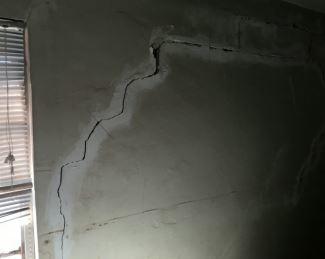Winslow, AZ Underpinning Installation System 7.2021
Challenge
The Homeowners of this 1956’s single-family home got in contact with us after noticing a few signs of foundation problems.
These signs of stress included:
- Cracks on the wall
- Wall-Cracks by the windows
- Cracks by the door
Exterior Inspection: The exterior of the location was visually inspected. Items such as foundation cracks, exterior wall cracks, improper grading, type of structure, poor drainage, gutters or no gutters, bowed retaining walls, large trees close to the foundation and any type of obstructions that may or may not influence the repair process were noted and recorded.
Interior Inspection: The interior of the location was visually inspected. Items such as floor cracks, wall cracks, ceiling cracks, sloping floors, uneven counter tops, doors and windows that are out of alignment, cracked window glass and bowed walls were noted and recorded.
Manometer Survey: The manometer survey, also known as a floor survey, is a measurement of the differences of interior floor elevations. The flatness of the interior floor was measured using a highly accurate survey device known as a Manometer. The entire interior floor area was surveyed, and the elevations were recorded. These data points were then entered into a computer program that provides a topographical map showing the high and low elevation contours of the floor surface. This topographical map shows where the foundation is no longer level and shows where support and stabilization are needed. The floor survey also demonstrates whether any floor slab heave or settlement exists.
After examining the home and performing the manometer survey, Arizona Foundation Solutions believes the home could be experiencing foundation settlement at the southern portions of the home as shown by the damage on the topographical map. The drop off in floor elevations on the topographical map is consistent with a foundation settlement pattern. Settlement can be caused by one or any combination of many factors including sub-grade saturation of moisture due to poor drainage, years of storm runoff, plumbing leaks, improper compaction, the lack of a proper foundation system, and/or (in most cases) natural earth movement. AZFS believes the home could be experiencing minor foundation settlement at the southern portion of the Enclosed Porch and northern portion of the Office (Addition) as shown on the topographical map.
The Foundation Performance Association (FPA) “Guidelines for the Evaluation of Foundation Movement for Residential and Other Low-Rise Buildings” were adopted to correlate acceptable and unacceptable distress phenomena with actual survey elevations. Deflection and Tilt calculations were performed and compared to allowable values. For this engineered analysis, the deflection of the slab (L/147) exceeds the allowable deflection limit of L/360. In addition, the tilt of the slab (0.23%) was less than the allowable tilt of 1.00%.
Solution
Arizona Foundation Solutions believes that the proper way to permanently stop the perimeter foundation settlement is to underpin the areas that are experiencing movement. Underpinning is the process of installing deep foundation elements called piles. Piles are engineered foundation supports that are driven down past the unstable soils and are then locked up into load bearing strata, which can support the loads that are transferred to them. Once the piles have been installed, they can be used to lift the perimeter foundation up to its Highest Practical Maximum. The piles should be spaced approximately six to eight feet on center and should start and stop near the hinge points of movement (exact spacing to be determined after load bearing calculations). In this case, the piles would be located at the south, southeast and southwestern portions of the home.
AZFS believes the best way to stabilize the support beams in the crawl space is with SmartJacks. These are adjustable galvanized supports engineered to be placed under the sagging floors to help prevent settlement of the floor joist system. The SmartJack sequence should start at approximately 2’ off each perimeter wall and should not be spaced more than 7’ on center (exact spacing to be determined after load bearing calculations). An engineered push pier will be driven concentrically beneath the beam at each Smart Jack location to provide a footing for each Smart Jack. If for whatever reason the installation of concentric piers is not possible, a concrete footing of engineered size will be poured beneath the smart jack to distribute the load. The SmartJacks will then be cut to size and set in place. Finally, the units will be adjusted to lift the sagging floors back to their best functioning point or the Highest Practical Maximum.
AZFS does not suggest a settlement repair plan, for the southern portion of the Enclosed Porch and northern portion of the Office, at this time as there is no significant damage to correspond with the elevation readings. The home should be monitored and should damage arise in the future, AZFS should be contacted to perform a comparative monometer survey at a discounted price.
Since storm runoff is responsible for the majority of the moisture that pools next to the foundation, gutters need to be installed to prevent the storm runoff from increasing the amount of foundation movement. A proper gutter system should be installed to discharge the storm runoff a minimum of 10 feet, preferably 20 feet away from the foundation. We do not recommend installing gutters that discharge next to the foundation as this will only increase the probability of a foundation problem.
Project Summary
Engineer: Michael R. Simpson



